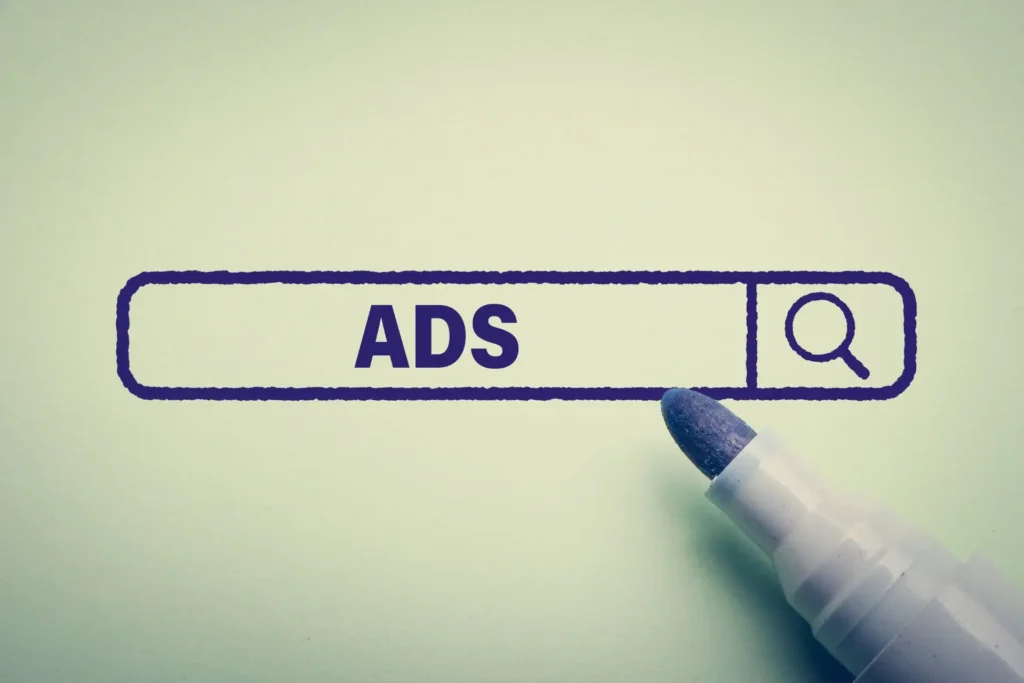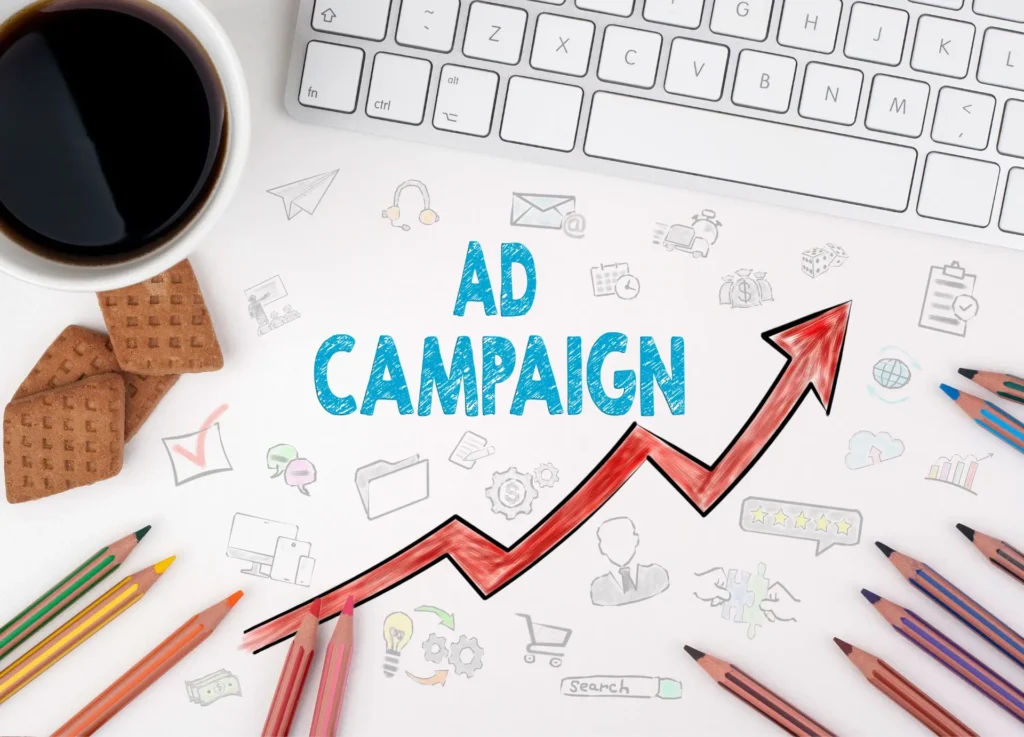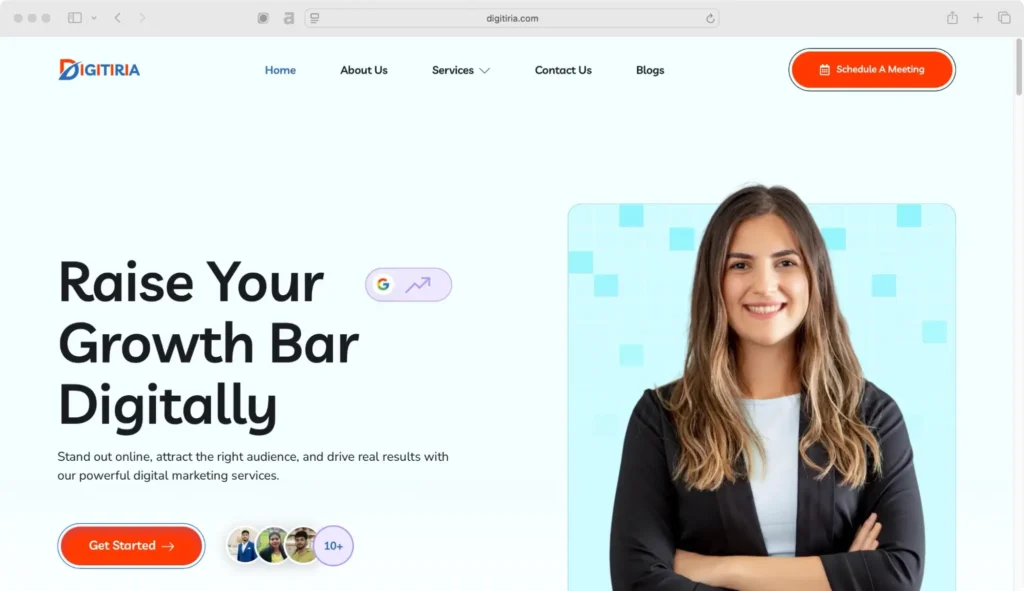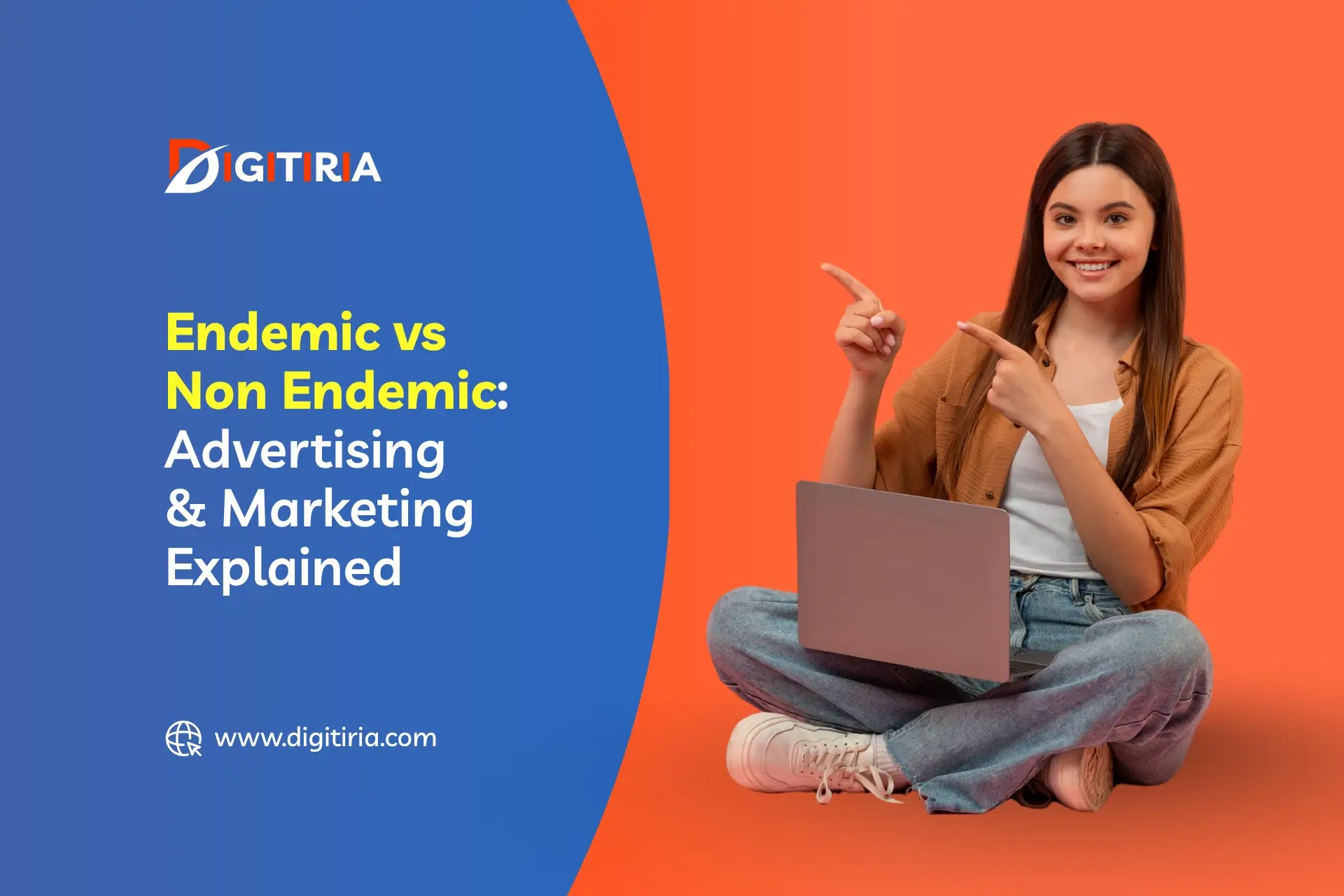Ever watched a Nike ad during a basketball game and thought, “well, that fits”?
Or maybe you saw a car insurance ad while streaming your favorite cooking show and thought, “Huh? What’s this doing here?”
If you’ve ever noticed how some ads feel perfectly placed while others seem out of place, then you’ve already experienced the difference between endemic vs non-endemic advertising without even knowing the terms.
I didn’t either, until a client asked me this exact question during a pitch meeting:
“Should we go endemic or non-endemic for our next campaign?”
And I’ll be honest, I paused for a second.
Because while these sound like fancy marketing buzzwords, they’re actually pretty simple when you break them down. And more importantly, understanding them can help any brand or business, including yours make smarter advertising decisions, especially if you’re targeting audiences in the US, UK or any other country.
Let’s dig in.
What is endemic advertising? (the ads that belong)

I first learned the power of endemic advertising while working with a boutique skincare brand trying to compete with the big dogs, think L’Oréal, The Ordinary, etc.
We didn’t have their budget, but what we did have was a deep understanding of our audience: 25–40-year-old women looking for clean, sensitive-skin products.
So instead of running broad Facebook ads or Google Display campaigns, we started small, placing sponsored posts on skincare blogs, dermatologist YouTube channels, and wellness newsletters that our ideal customer was already following.
One post on a UK-based skinfluencer’s blog brought in more traffic and sales in a week than a month’s worth of paid search.
Why? Because it was endemic. It felt natural. Trustworthy. Like a friend’s recommendation, not a banner ad.
You can think of endemic advertising like showing up at the right party in the right outfit.
In summary, you’re placing your ad in a space where it naturally fits, where the people already care about what you’re selling.
Here’s how you know you’re running an endemic ad:
- Your ad matches the topic or category of the platform (ex: fitness gear on a workout app).
- The audience already has the intent or interest.
- You’re offering value, not interruption.
Here’s a simple example:
- Selling protein powder? Place your ad on a fitness blog.
- Launching a skincare line? Partner with a beauty YouTuber.
- Running a fertility clinic? Advertise on women’s health podcasts or parenting forums.
These ads work because they don’t feel like ads. They feel like helpful, relevant content.
Benefits of endemic advertising
- High trust: You’re in a space your audience already trusts.
- Better ROI: Because of high relevance, clicks and conversions often cost less.
- Contextual alignment: Messaging feels organic, not forced.
But let’s not pretend it’s all perfect…
Limitations of endemic advertising
- Limited scale: You’re targeting a specific niche which may not scale fast.
- Saturation risk: If everyone’s advertising in the same space, your brand can blend in too much.
- Higher CPMs (cost per thousand impressions) in some verticals: Especially in industries like finance, healthcare, or tech where endemic placements are premium.
Why I love endemic ads (especially for niche brands)

Well it’s because it something where
👉 You’re directly talking to a warm audience who already care.
👉 Conversion rates are usually higher.
👉 It builds trust and you look like you belong there.
I once ran a campaign for a wellness brand targeting women in their 30s. We went with endemic placements on health and fertility websites, and the click-through rate tripled compared to their previous social campaigns. No gimmicks, just context.
What is non-endemic advertising? (the ads that interrupt)

Now let’s talk about non-endemic advertising, the cousin who shows up uninvited but still makes an impression.
These are ads that don’t directly relate to the content they appear next to. And sometimes, that’s okay. Maybe even strategic.
Let me tell you something, about a year ago, I worked with a US-based financial app (can’t disclose the name) looking to reach Gen Z. Naturally, you’d think to advertise on finance blogs, right? But Gen Z doesn’t read finance blogs, they’re on TikTok, Twitch, Spotify, and gaming platforms.
So we partnered with a few gaming streamers and even placed banner ads on music apps like Pandora and SoundCloud.
Guess what? One non-endemic placement, an in-game ad during a live-streamed Valorant match, brought 45% more app installs than our finance forum campaigns.
That’s non-endemic advertising.
It doesn’t “belong” in space… but it gets noticed.
It relies on curiosity, timing, or pure reach.
Examples of non-endemic can be:
- A real estate ad on a cooking website.
- A banking app ad on a gaming livestream.
- A luxury watch brand sponsoring a tech podcast.
Benefits of non-endemic advertising
- Wider reach: Tap into massive audiences where your competitors might not be present.
- Category crossover: Reach potential customers in new life moments (ex: advertising moving services on a wedding blog).
- Creative flexibility: You can experiment more with voice, tone, and style.
Limitations of non-endemic advertising
- Lower intent: The audience may not care sometimes yet it’s a cold pitch.
- More creative pressure: You need a hook that grabs instantly.
- Risk of irrelevance: Poor placements feel like spam and can hurt your brand image.
Endemic vs non-endemic in different industries

Let’s talk about some industries where this difference really matters. From healthcare to sports to tech, the way you advertise and where you show up can change everything. Here’s how endemic vs non-endemic plays out in the real world.
Endemic vs non-endemic in healthcare marketing

Healthcare is one of the most sensitive and trust-driven industries and that changes how you think about advertising. Whether you’re marketing fertility clinics, mental health apps, telemedicine platforms, or wellness brands, the line between trust-building and trust-breaking is thin.
One of my friends has worked with a US-based fertility diagnostics brand, and here’s what I learned from in convos between us: If your ad feels out of place, it’s not just ineffective, it can feel unethical.
That’s why endemic advertising is the go-to strategy for most healthcare brands.
Endemic healthcare ads (trust-first approach)
- Fertility services advertised on women’s health platforms like Flo, WhatToExpect, or IVF forums.
- Telehealth apps partnering with wellness YouTubers or therapists on Instagram.
- Mental health tools featured in mindfulness podcasts or ADHD newsletters.
These placements work because they match the mental state of the audience. If someone’s reading an article on anxiety or hormonal imbalance, they’re already open to hearing about solutions, especially if it comes from a trusted source.
Non-endemic healthcare ads (risky but scalable)
That said, I’ve also seen non-endemic placements succeed when done with care.
Here’s an example:
A UK-based meditation app ran YouTube ads during productivity and career videos, not exactly health-focused. But their ad was cleverly framed:
“Too stressed to work? Here’s 2 minutes of calm.”
That hook worked. It didn’t feel intrusive. It offered immediate value. And it met the user where they were.
What to watch for in healthcare ads
- Compliance is key. Certain health claims can’t be made casually in non-endemic spaces.
- Creative tone matters: If the ad feels out of sync with the content, it might trigger fear or mistrust.
- Endemic = safer, but non-endemic can scale if done smartly and sensitively.
Endemic vs non-endemic in media and sponsorships

Media is where the real showmanship of advertising plays out: TV, streaming, podcasts, events, influencers, sports, music and a lot more. And if there’s one place where the line between endemic and non-endemic is both blurred and brilliant, it’s here.
Let me share a quick story.
Back when the same friend was consulting for a tech startup launching a productivity tool, they debated whether to sponsor a popular SaaS podcast (clearly endemic) or go bold and place an ad during a live esports stream (definitely non-endemic).
Guess what worked better?
Both!
Yes, you read it right, but in different ways.
The podcast brought in high-intent users who signed up for trials.
The esports stream brought in younger users who didn’t convert immediately, but followed us on social and remembered our brand later.
That’s when I realized: In media and sponsorships, it’s not about either/or, it’s about how and where you show up.
Endemic sponsorships (right place, right crowd)
These are brand partnerships that organically fit the content or event. You’re not just sponsoring, you’re contributing to a shared vibe.
Examples:
- Nike sponsoring ESPN segments or NBA halftime shows
- Salesforce sponsoring B2B tech events or podcasts
- Barbour working with British countryside magazines and documentaries
- Huel sponsoring UK health and performance podcasts like Feel Better, Live More
Endemic sponsors feel like they belong. They complement the media, rather than distract from it.
Non-endemic sponsorships (unexpected, but memorable)
Here’s where it gets interesting. Non-endemic sponsors don’t “belong” in the content… but if the message is right, they steal the spotlight.
Examples:
- Mastercard sponsoring Coachella (not music-related, but tied to experiences and payment solutions)
- Charmin running hilarious ads during Super Bowl halftime, no relation to sports, but unforgettable
- HSBC sponsoring Wimbledon (not a tennis brand, but aligns with British prestige and global banking image)
- Compare The Market doing cinema partnerships and reality TV tie-ins
Non-endemic sponsorships work when the brand brings value, entertainment, or unexpected delight to the audience.
Like when Red Bull sponsored art exhibitions, it wasn’t about energy drinks, it was about energizing culture.
So… when should you use endemic vs non-endemic?

If you’re still unsure, here’s a dead-simple framework I use with clients, especially useful for startups and small brands managing budgets.
Start with your goal
Ask yourself:
- Do I want conversions now? → Start endemic
- Do I want reach or awareness? → Explore non-endemic
Know your audience’s mindset
- Are they actively looking for your solution?
(Think: searching for PC gear, fertility help, or skincare) → Endemic - Are they open to discovery but not actively seeking?
(Think: casual listeners, video watchers, gamers) → Non-Endemic
Consider your creative budget
Let’s be real: Non-endemic ads require better creativity: stronger hooks, faster impact, clearer messaging.
If you can’t invest in good copy and scroll-stopping visuals? Stick with endemic until your creative muscle grows.
Think hybrid – it’s not either/or
In most of my client campaigns, the winning strategy is both. We build trust and conversions via endemic, then layer in non-endemic to expand reach and test new angles.
Digitiria tip: Use endemic channels to warm up your audience, then retarget them on non-endemic platforms with broader, brand-focused content.
So… Where should your brand show up next?
The truth is, there’s no single right answer.
Sometimes your brand fits perfectly into a space (like sneakers on a fitness blog), and other times it makes a bold entrance where no one expects it (like a fintech app at a music festival). Both approaches: endemic and non-endemic can work. But only if you understand your audience, your timing, and what story you’re trying to tell.
If you’re feeling stuck between the two, you’re not alone.
Most founders and marketers I work with struggle with this exact question:
“Do we double down on relevance or cast a wider net?”
And honestly, the answer usually lies in testing, tweaking, and trusting your instincts, with a bit of strategy and storytelling thrown in.
That’s where we come in.

At Digitiria, we don’t just run ads, we help brands figure out where they belong and why. Whether it’s endemic placements that drive laser-focused conversions or non-endemic experiments that help you break into new markets, our team blends data, creativity, and a whole lot of human insight to craft campaigns that actually work.
No fluff. No guesswork. Just clear, strategic moves tailored to your brand and goals.
So if you’re ready to stop throwing spaghetti at the wall and start placing your brand exactly where it needs to be, let’s talk.
👉 Visit Digitiria or drop us a message. We’ll help you make every ad feel like it belongs.
FAQs
What is the main difference between endemic and non-endemic advertising?
Endemic advertising appears in places that are directly related to your product or industry, like a skincare brand on a beauty blog. Non-endemic advertising shows up in unrelated spaces, like a bank ad during a cooking show to reach a wider audience.
Which is more effective: endemic or non-endemic ads?
It depends on your goal. Endemic ads usually convert better because they’re more relevant. Non-endemic ads help build brand awareness and reach new audiences. A mix of both often works best.
Are non-endemic ads riskier for healthcare brands?
Yes, because healthcare marketing requires trust and sensitivity. Non-endemic ads can work, but they need the right message and creative tone. Endemic placements are often safer and more effective for health-related services.
How do I decide where to place my ads?
Start by asking: Who is my audience? Where do they hang out? What do I want them to do? If you’re not sure, working with a digital marketing partner like Digitiria can help you test both types of placements and find what clicks.


